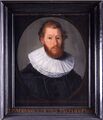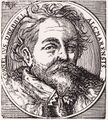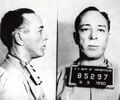Template:Selected anniversaries/December 9: Difference between revisions
No edit summary |
No edit summary |
||
| Line 89: | Line 89: | ||
||1974: Joseph Gilbert Hoffman dies ... physicist and biophysicist who brought atomic isotopes into the battle against cancer. During WW II, he developed a radio proximity fuse and later was a health-physics scientist with "Manhattan Project." Hoffman studied nine accident victims of radiation disease at Los Alamos in Aug 1945 and May 1946. This research revealed for the first time that atoms of living human tissue could be transformed into radioactive atoms. He recognized "a completely new approach to studying the metabolism of atoms in living tissue and a new way of probing the complicated system of gene cells that determine heredity," and such knowledge was indispensable to understanding the mysteries of cancer research in which he engaged for the rest of his life. Pic: https://www.todayinsci.com/8/8_19.htm | ||1974: Joseph Gilbert Hoffman dies ... physicist and biophysicist who brought atomic isotopes into the battle against cancer. During WW II, he developed a radio proximity fuse and later was a health-physics scientist with "Manhattan Project." Hoffman studied nine accident victims of radiation disease at Los Alamos in Aug 1945 and May 1946. This research revealed for the first time that atoms of living human tissue could be transformed into radioactive atoms. He recognized "a completely new approach to studying the metabolism of atoms in living tissue and a new way of probing the complicated system of gene cells that determine heredity," and such knowledge was indispensable to understanding the mysteries of cancer research in which he engaged for the rest of his life. Pic: https://www.todayinsci.com/8/8_19.htm | ||
||1974: Dr. Walter Guyton Cady dies ... physicist and electrical engineer. He was a pioneer in piezoelectricity, and in 1921 developed the first quartz crystal oscillator. Pic: https://ieee-uffc.org/about-us/history/walter-guyton-cady-memorial-page/ | |||
||1979: The eradication of the smallpox virus is certified, making smallpox the first and to date only human disease driven to extinction. | ||1979: The eradication of the smallpox virus is certified, making smallpox the first and to date only human disease driven to extinction. | ||
Revision as of 17:49, 2 September 2018
1571: Mathematician and astronomer Adriaan Metius born. He will manufacture precision astronomical instruments, and published treatises on the astrolabe and on surveying.
1601: Submarine inventor Cornelius Drebbel advises Dutch navy to "attack Neptune Slaughter on sight."
1718: Monk, cosmographer, and cartographer Vincenzo Coronelli dies. He gained fame for his atlases and globes; some of the globes are very large and highly detailed.
1814: Physician Golding Bird born. He will pioneer the medical use of electricity.
1868: The first traffic lights are installed, outside the Palace of Westminster in London. Resembling railway signals, they use semaphore arms and are illuminated at night by red and green gas lamps.
1868: Chemist Fritz Haber born. He will receive the Nobel Prize in Chemistry in 1918 for his invention of the Haber–Bosch process, a method used in industry to synthesize ammonia from nitrogen gas and hydrogen gas.
1883: Mathematician, theorist, and academic Nikolai Luzin born. He will contribute to descriptive set theory and aspects of mathematical analysis with strong connections to point-set topology.
1905: Screenwriter and novelist Dalton Trumbo born.
1917: Mathematician and philosopher Georg Cantor publishes new theory of sets derived from Gnomon algorithm functions. Colleagues hail it as "a magisterial contribution to science and art of detecting and preventing crimes against mathematical constants."
2014: Cryptographic numen modeled in nanowire, functions as cluster of tiny scrying engines.









